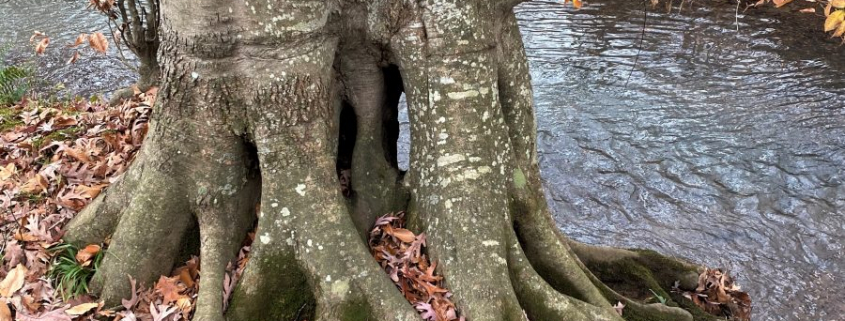Early December Forest Treasures within a Two-Acre Area of Riparian Forest
December 6, 2020, I biked 18 miles, ten of them making two loops on the Bradford Creek Greenway in Madison, Alabama. Dismounting back at my vehicle in the Heritage Elementary School parking lot, I changed into hiking boots and a field jacket to explore a small section of the riparian forest just one-quarter mile down the trail. I limited my up-close exploration to what turned out to be about two acres, all within 165-feet of a central point just off the trail.
I offer a montage of images… a photo-essay heavy on photos and light on essay (verbiage). I see an order of magnitude more when I’m cycling at 10-14 MPH compared to when I am driving at 60+ MPH. Give me another order of magnitude more visual gifts on foot in the forest, wandering to whatever captures my attention… tree, shrub, vine, moss, or trunk-cavity!
Photogenic American Beech
I do notice this stream-bank-hugging American beech from the greenway, especially during the leafless season. I admire its tenacity… its insistence on holding tightly to terra firma. I presume that at some point as a seedling this individual sprouted from a soil mound thrown up from an uprooted tree. The seedling’s roots reached down and around the soil mound, since somewhat worn away by stream flooding. Today its stilt-legs hold the trunk some 18 inches above the current ground level. Below left the stream is visible between the legs. This seeming tranquil, streamside perch belies the violence that a night of heavy rain can bring to Bradford Creek. The view below right gives a more complete picture of the clinging roots, the perspective enhanced by the persistent gold-brown leaves that will hold on until spring leaf-out abscises the leaf hangers-on.
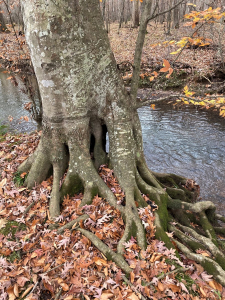
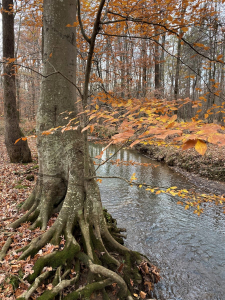
The beech and I are smitten with the stream… the beech for the vital moisture and the soil amendments delivered with each freshet; and me for the emotional and spiritual restorative balm afforded by biking or hiking along its shore.
Vine Haven
The Society of American Foresters defines a forest as an ecosystem characterized by more or less dense and extensive tree cover usually consisting of stands varying in characteristics such as species, structure, composition, age class, and commonly including streams, fish, and wildlife —note forests include special types such as industrial, non-industrial, public, protection, urban, as well as parks and wilderness; they are commonly managed to sustain single or diverse products or special values.
The two acres I am bringing to your attention is, in fact, characterized by dense and extensive tree cover. Dense shade comforts my June through September bike rides. But the forest shade derives from more than the tree foliage. The overstory sunshine is shared with multiple species of woody vines that ascended into the crown with the trees as they grew from seedling and sapling stages into the canopy 70-100 feet above the forest floor. Our diverse southern forest vineage (my word, not recognized in any of the online dictionaries I consulted) includes grape, trumpet vine, poison ivy, supple jack, scuppernong, Virginia creeper, crossvine, Dutchman’s pipe vine, and others. As I’ve matured as a naturalist into retirement, I have become more and more enamored with such vineage, which, I assure you, is now a word — I have added it to my personal online dictionary!
I am striving to understand and seek to explain what remains inexplicable vine forms, twists, and knots. This grapevine presents a ten-foot-high archway. Something the druids created as a portal to who-knows-where? I chose to walk through it, disappointed that I simply found myself on the other side… not in some alternate dimension. The business end of this arch reaches into the crown, where it competes for light that does not penetrate to the forest floor.
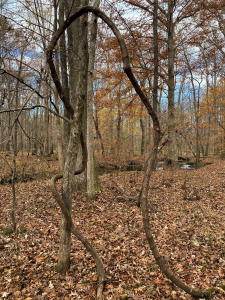
This supple jack (green-barked) is writhing a slow dance with a grapevine… twisting, binding, and strangling to a draw. Like their arched cousin, both of these individuals (if you can separate them) have found space in the main canopy far above.
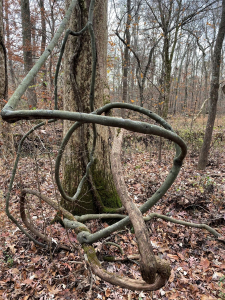
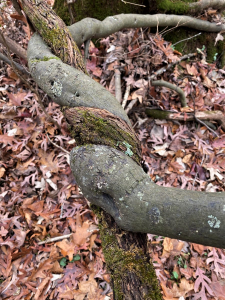
Supple jack fascinates me. This three-inch diameter vine (below left) carries its green color even deep within the understory. Is its green bark actively photosynthesizing? Or is its olive green hue simply for show… and for what purpose? The woodpecker that drilled the half-dozen holes below left found purpose in the vine… either in form of insect larvae within… or an intent to instigate sap flow to attract insects for a later snack. I like the gnarls the vine creates in its ultimate struggle to maintain main canopy purchase and function (below right). During my timber beast forest products industry years, vines worked at cross-purposes with my own. They competed with crop trees for moisture, nutrients, and sunshine. They increased susceptibility to ice and wind breakage… and complicated felling, trimming, and bucking into merchantable log-lengths.
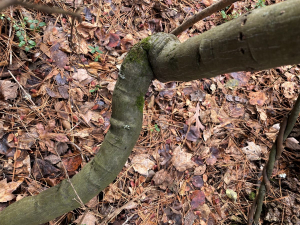
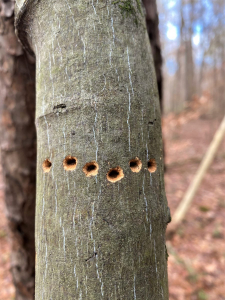
I accept, even embrace, vineage now. For reasons aplenty: aesthetics, wildlife food and habitat, fascination and curiosity! Richness in my estimation has shifted from economic to diverse other values.
Decorative Moss
Life has changed in so many ways since I retired from university leadership positions, when days often raced past in a blur. Today, the days still begin before dawn, but the pace is far more relaxed, comfortable, and rewarding. The two photos below epitomize the slackening pace. I can (and do) take time now to see, absorb, and photograph a forest floor woodland still life. I repeat what I’ve said many times in these Posts. I prefer Nature paintings that look like photographs; I love photographs that could be paintings. How could even a talented artist possibly best these images of downed wood, time-polished, and festooned with magic mosses?!
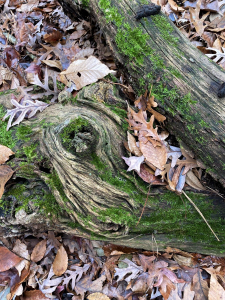
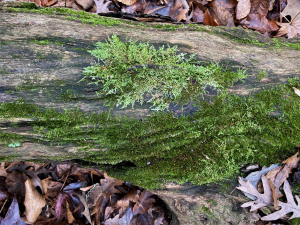
Wolf Tree, an old forestry term — denotes a tree that originated in a more open condition, this one probably in an abandoned field prior to the current younger forest filling in around it. Large branches and coarser crown. This tree was a loner, like a lone wolf. From a 1945 edition of American Forests magazine — an article titled Woodman, Spare that Wolf Tree: “…these ugly wolf trees, these snags, these trees classified as worthless space fillers are valuable wildlife units in the vast stretch of North American woodland.” I see wolf trees often through our north Alabama second- and third-growth forests. Each has a story to tell.
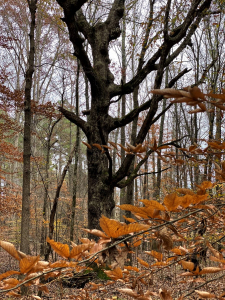
Many people inadequately schooled in the ways of Nature subscribe to the notion that moss grows only on the north side of trees. Finding oneself navigationally, therefore, is as simple as orienting to the mossy side of a tree. However, moss thrives in moist shade. In certain climatic zones, the rule may hold here in the northern hemisphere. In our deep forests of dense understory shade and abundant rainfall, the rule weakens in practice. The thirty-inch diameter white oak (Quercus alba) wolf tree above serves well as the exception to the north-side-moss rule.
Below left the tree’s north side does indeed carry a rich American tree moss-coat at its base. Deep shade, plenty of moisture. Let’s swing to its east flank (below right) and examine the result. Deep shade; thick moss coat. Surely, the south side will not be as moss-cloaked.
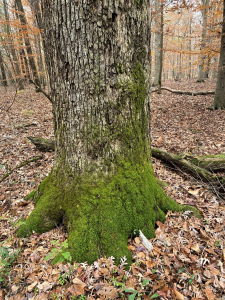
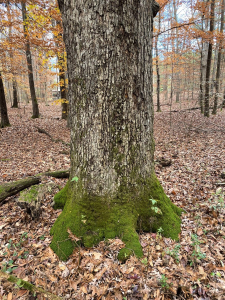
Yet, I detect no difference (below left). Are we lost yet? In our region of ample rainfall across the seasons, the near-ground micro-climate stays moist. Stem flow concentrates rainfall, ensuring that the trunk base is well-saturated with most rain events that yield at least a half an inch. That stem flow also delivers nutrients washed and leached from the canopy and stem above. Below right we get another glimpse of the wolf tree’s coarse crown.
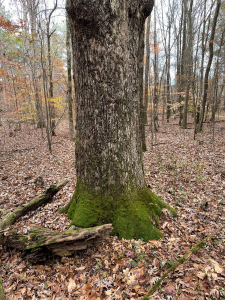
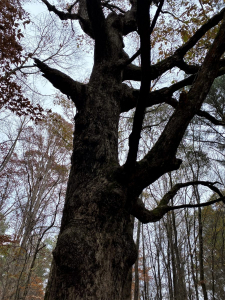
A nearby yellow poplar (Liriodendron tulipifera) likewise sports a moss-green skirt. I appreciated the cross-ribboned mockernut hickory (Carya tomentosa) trunk (below right) accented by a lacey moss-matrix. Were I more entrepreneurial, I would consider marketing a line of wallpaper (or placemats or tee-shirts or murals or coffee mugs) employing such imaginative real-life images of tree bark. Anyone care to explore such an enterprise with me? I have lots of such tree bark images in my archives.
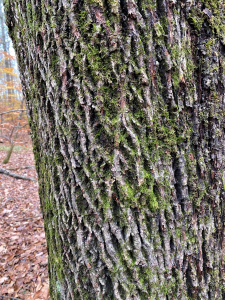
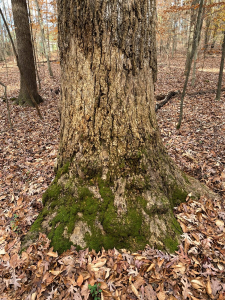
I am sure this hollowed sweetgum (Liquidambar styraciflua) tells a tale of former injury, introduction of decay fungi, callousing, and use by critters of many stripes and colors. I include the sweetgum here because it stood out among others in my two-acre exploration… and because it, too, carried a mossy skirt.
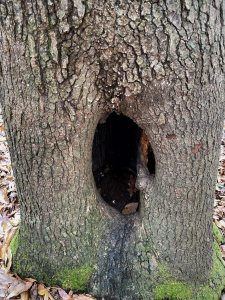
I wonder how many of my fellow trail bikers, walkers, runners, and other casual users notice the forest riches along the greenway. I see far too many, for my taste, distracted and isolated by the world they pipe-in via ear buds, obstructing the beauty, magic, and awe otherwise enveloping them. Some days I am tempted to slow my wanderings an additional order of magnitude by finding a downed log or comfy buttressed tree base upon which to sit and contemplate life…my own and of the forest. John Muir knew the blessings of quiet wildland contemplation:
I only went out for a walk, and finally concluded to stay out till sundown, for going out, I found, was really going in.
All the wild world is beautiful, and it matters but little where we go, to highlands or lowlands, woods or plains, on the sea or land or down among the crystals of waves or high in a balloon in the sky; through all the climates, hot or cold, storms and calms, everywhere and always we are in God’s eternal beauty and love. So universally true is this, the spot where we chance to be always seems the best.
Life in the Understory
Sapling and seedling American beech (Fagus grandifolia) insist upon holding persistent golden foliage until new spring leaves jettison them. Nothing spectacular, yet a dose of color that brightens our winter woods. I was pleased to see several specimens in my two-acre woods.
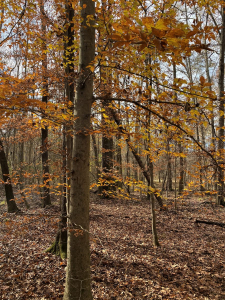
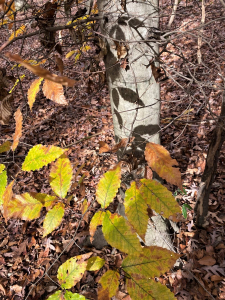
This four-inch diameter black cherry (Prunus serotina) is surviving through an infection (disease) called black cherry canker. The internet sites I visited attribute such growth variously to fungal and bacterial infection. In simple terms, the canker is a benign tree tumor, in this case three times the tree’s diameter. Somehow the tree continues to transport water, nutrients, and carbohydrates sufficient for survival, albeit barely. The tree is dwarfed, and will never make it beyond the mid-canopy. The old child in me imagines severing the stem at the canker’s upper surface and at ground level… yielding a four-foot club, a fine weapon for use against forces from the dark side. A homemade Middle Ages battle club. If I squint my eyes just right, I can see a face with distinct forehead, eye brows, eyes, prominently ridged cheeks, nose, misshapen mouth, and chin. Perhaps the glass of Malbec for dinner has sharpened my vision (or imagination).
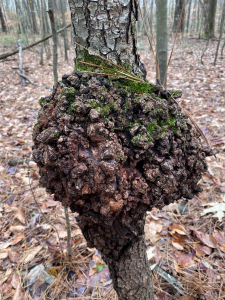
My woods ramblings spur imagination, encourage inspiration, and lead me to an inner place of serene humility.
Thoughts and Reflections
I offer two observations from my early-December two-acre wanderings:
- From Leonardo da Vinci — So universally true is this, the spot where we chance to be always seems the best.
- My woods ramblings spur imagination, encourage inspiration, and lead me to an inner place of serene humility
-
Inhale and absorb Nature’s elixir. May Nature Inspire, Inform, and Reward you!
Note: All blog post images created & photographed by Stephen B. Jones unless otherwise noted. Please circulate images with photo credit: “©2021 Steve Jones, Great Blue Heron LLC. All Rights Reserved.”
Another Note: If you came to this post via a Facebook posting or by an another route, please sign up now (no cost… no obligation) to receive my Blog Post email alerts: http://eepurl.com/cKLJdL
And a Third: I am available for Nature-Inspired Speaking, Writing, and Consulting — contact me at steve.jones.0524@gmail.com
Reminder of my Personal and Professional Purpose, Passion, and Cause
If only more of us viewed our precious environment through the filters I employ. If only my mission and vision could be multiplied untold orders of magnitude:
Mission: Employ writing and speaking to educate, inspire, and enable readers and listeners to understand, appreciate, and enjoy Nature… and accept and practice Earth Stewardship.
Vision:
- People of all ages will pay greater attention to and engage more regularly with Nature… and will accept and practice informed and responsible Earth Stewardship.
- They will see their relationship to our natural world with new eyes… and will understand more clearly their Earth home.
Tagline/Motto: Steve (Great Blue Heron) encourages and seeks a better tomorrow through Nature-Inspired Living!
Steve’s Three Books
I wrote my books Nature Based Leadership (2016), Nature-Inspired Learning and Leading (2017), and Weaned Seals and Snowy Summits: Stories of Passion for Place and Everyday Nature (2019; co-authored with Dr. Jennifer Wilhoit) to encourage all citizens to recognize and appreciate that every lesson for living, learning, serving, and leading is either written indelibly in or is powerfully inspired by Nature.
I began writing books and Posts for several reasons:
- I love hiking and exploring in Nature
- I see images I want to (and do) capture with my trusty iPhone camera
- I enjoy explaining those images — an educator at heart
- I don’t play golf!
- I actually do love writing — it’s the hobby I never needed when my career consumed me
- Judy suggested my writing is in large measure my legacy to our two kids, our five grand kids, and all the unborn generations beyond
- And finally, perhaps my books and Blogs could reach beyond family and touch a few other lives… sow some seeds for the future


All three of my books (Nature Based Leadership; Nature-Inspired Learning and Leading; Weaned Seals and Snowy Summits) present compilations of personal experiences expressing my (and co-author Dr. Wilhoit for Weaned Seals and Snowy Summits) deep passion for Nature. All three books offer observations and reflections on my relationship to the natural world… and the broader implications for society. Order any and all from your local indie bookstore, or find them on IndieBound or other online sources such as Amazon and LifeRich.

